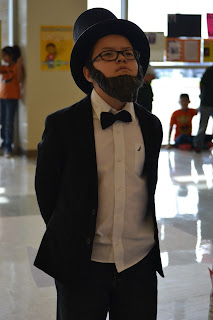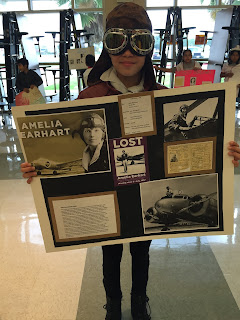by Dorcas Hand, Co-Chair, TASL Legislative & Advocacy Committee
HISD’s Hogg
Middle School Librarian Mary Chance and her Principal Angela Sugarek pulled
together the attached flyer for the official opening of the updated library at Hogg
this past Thursday evening.
They saw an opportunity in the gathering of
parents, their school board rep, HISD Curriculum folks, other principals and
random community folk like me. The numbers all come from HISD data streams
available to them in their regular work; the
numbers matter to us as an example of how to use numbers to illustrate needs – especially
as we look ahead to putting school libraries in the center of the Nov. 1, 2015 Every
Student Succeeds Act (ESSA) implementation. Their tool for the infographic was District circulation
numbers for 2015.
First, a
simple pie chart in red and black tells us that 52% of HISD libraries have an average collection age of over 21 years –
that sounds musty and dusty, hardly appealing to student readers. Only 3% of HISD schools can boast a
library collection less than 10 years old. Best practices for libraries suggest
that an average collection age of 10 years allows the older fiction but
requires the newest nonfiction in a blend that supports student interests as
well as curricular needs.
Now, how
many books were checked out to students in 2015? 33% of students across the district never borrowed a single book. Seriously???
No wonder there is a literacy gap in the test scores. Students without access
to books that interest them are at great risk to never read well.
A quick look
at staffing tells us that 20% of HISD libraries have no designated staff and
another 26% have only a paraprofessional managing circulation. 22% have
teachers standing in for librarians, leaving only 32% of HISD libraries as staffed with certified personnel.
And then we
compare the circulation data to the Texas Education Agency Accountability
Ratings. 58% of students in schools that met standards borrowed only 1-9 books
in 2015. 87% of students in schools the Improvement Required category have borrowed
only 1-9 books in 2015. When we compare to TEA Staffing standards, only 34% of schools that Met Standard have a Librarian; only 25%
of schools in the Improvement Required
category have a librarian. These are simple, basic connections to
illustrate to HISD campus and district leadership the importance of strong campus
libraries with certified and degreed librarians for every K-12 student. This is
how we begin to fortify implementation of school libraries through ESSA.
HISD School
Board had proposal B9 on the agenda for the Jan 15 meeting; it was postponed to
the Feb. 11 meeting. The Board hopes to
level the playing field by implementing for all schools an FTE librarian and
nurse. Some principals have strong budget concerns, which the district is
working to allay. It will be an interesting meeting for sure. Principals like Ms.
Sugarek can speak to the fact that even with current budgeting, librarians contribute to student success in ways that make them essential personnel. Essential personnel is the category to
which school librarians have been added in ESSA. Principals who have not
known a strong library program before see tutors and literacy coaches as more
essential. It will be up to librarians to change this trend by speaking out
again and again, demonstrating the impact that we do have – and building our
case for inclusion in ESSA implementation planning..
The lesson
for other districts - well, a lesson – is that bringing up to Board
representatives the benefits of strong libraries even when there is no
immediate agenda item seeds the idea into their vocabulary. Students Need
Libraries in HISD has been doing exactly that for the last couple of years –and
look what happened. We didn’t know it was coming, and it isn’t a done deal by
any means – but we did get the conversation on the table. When it passes (now
or eventually), we’ll still have plenty of work to do bringing those resistant
principals on board.
So look to
your data. Make it work for you.
ASIDE:
Remember that Google Form I posted recently, the one to collect Measurable
Impact Activities: http://goo.gl/forms/6jlw2PUL5O Please consider what you can contribute
there – the data will be useful to all of us when we work with our School
Board, district leadership, TEA, all of the above to have a stronger position for ESSA planning.





